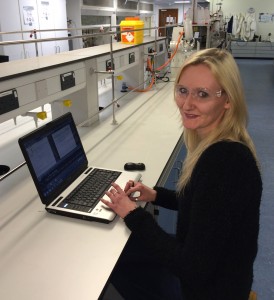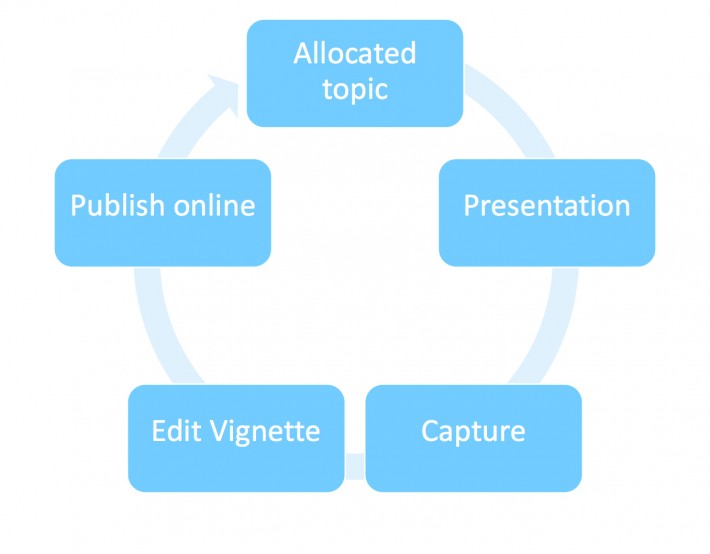Prof Simon Lancaster, University of East Anglia, explains how student authoring of video content produces positive learning outcomes and a lasting digital legacy.
 About the Author: Prof Simon Lancaster is Professor of Chemical Education at the School of Chemistry, University of East Anglia. In 1996 the RSC awarded him the Laurie Vergnano prize for the best contribution to Inorganic Chemistry by a young researcher for his work on Early Transition Metal Alkyl Cations and their role in Polymerisation Catalysis. He then spent four years as a research officer at the University of Leeds. In February 2000 Prof Lancaster returned to UEA as a Lecturer in Inorganic Chemistry and was promoted to Senior Lecturer in 2009 and Professor in 2014. He is currently Director of Admissions.
About the Author: Prof Simon Lancaster is Professor of Chemical Education at the School of Chemistry, University of East Anglia. In 1996 the RSC awarded him the Laurie Vergnano prize for the best contribution to Inorganic Chemistry by a young researcher for his work on Early Transition Metal Alkyl Cations and their role in Polymerisation Catalysis. He then spent four years as a research officer at the University of Leeds. In February 2000 Prof Lancaster returned to UEA as a Lecturer in Inorganic Chemistry and was promoted to Senior Lecturer in 2009 and Professor in 2014. He is currently Director of Admissions.
From flipped learning to flipped teaching: student authoring of learning on screen
In issue 103 of Viewfinder Dr Damien Mansell introduced flipped learning: the idea that students might prepare for face-to-face teaching by viewing content-rich videos or reading selected materials. In many HE disciplines this is far from a radical innovation. Indeed it is difficult to imagine an English literature seminar in which the students have not already read the book. However, in the sciences and elsewhere, the focus has traditionally been on the academic to deliver the material and the student to ‘independently learn’. The value of flipped learning is that it frees up contact time from the mere delivery of content, allowing time to probe and develop understanding through active learning approaches. I have found this approach both liberating and highly effective, and have become a vocal advocate for active learning.
Here I would like to suggest we can go further than simply flipping the location in which the learning is anticipated to happen. In his article, Damien discusses one of the key challenges in contemporary higher education, achieving student engagement. At the same time as engaging our students we need to equip them with much more than subject-focused conceptual understanding. Increasingly employers and society require an array of translatable soft skills in communication and digital literacy for instance. But what of the over-stretched academic balancing their research and administrative responsibilities?
In training presentations to new academics I advocate a three-year programme for introducing flipped teaching:
- Year one: familiarise yourself with the material, reflecting on where you believe the conceptual challenges lie
- Year two: capture your teaching using a convenient video technology
- Year three: use the videos from year three as pre-contact content and employ active learning pedagogies in the classroom
If you are experienced you can skip to year two, if you have time to burn you can record elsewhere and skip to year three. If you are in a hurry and you do not have time to burn, but want a video-focused approach to the content, then both YouTube and Learning on Screen’s on demand service BoB, can be valuable resources.

MChem student, Katie Resner editing a vignette. Photograph by Rachel Smith.
But, what do we do if we want to deliver an active learning experience on material for which no suitable media content exists, and we have no time to produce resources? How do we answer those critics of flipped teaching that do not harp back to the primacy of the lecturer but instead argue that it does not go far enough in engaging the student in their learning? Can we combine subject-level content acquisition and conceptual understanding with other precious graduate attributes? In our student-authored vignettes project I believe we have positive answers to all these questions.
At UEA our approach has evolved from a Higher Education Academy-funded Chemistry Vignette project. Having routinely captured my teaching since the days when I delivered largely-traditional lectures, I do not regard lecture capture per se as a significant change in HE. Yes, it is popular with students when first introduced but how will it be regarded by incoming first years who have known no different? Lecture capture will become part of the furniture much as note repositories on our virtual learning environments are now. The value of lecture capture is only realised when it is used to facilitate real change in the way we teach, as Damien described.
When I made recordings of my teaching available to my students I saw no discernible impact on attendance. What was interesting was the pattern of use. By far the most popular time to view the recordings was in the exam preparation period. Some of our students appeared to be binge-watching the recordings the night before the exam! This is not how we anticipated or wished to see our teaching resources being used. Furthermore, as an advocate of active learning, I was appalled by the notion of students passively consuming hour after hour of me. Our solution was the Chemistry Vignette. The vignettes were edited from 50 minute lectures down to one or two five-minute videos focussed on key concepts. We then reintroduced the interactive aspect through posing a series of multiple-choice questions.
Very few degrees are complete without opportunities for students to give presentations. The ability to present and answer questions is regarded as a key graduate attribute. Chemistry is a synoptic subject. Concepts students learn in their first year underpin advanced applications they encounter in their final year. However, our modularised education system and focus on examination technique can lead even accomplished students to believe that learning is temporary and there is little real constructive progression. To counter this we included a synoptic element to our degree programme. Rather than have academics reprise their earlier lectures this proved an opportunity for students to (re-)teach each other through sharing notes and delivering seminar-like presentations. Given the success of our chemistry vignettes, it was an obvious initiative to facilitate our students going the extra mile and turning their presentation into vignettes.

Figure 1, the five step approach.
Our approach can be summarised in five steps (figure 1). Students were paired at random and allocated one of the synoptic revision topics. They were invited to send a draft of their presentations for review. Feedback was provided in the form of a video screencast in which we stepped through the presentation. Students could then integrate this feedback into the presentation delivered to the whole class. The talks were captured using Camtasia. Significantly, because student peers recognised that this was not the end of the process, they offered very constructive criticisms of the presentations, which the group could address when editing their vignette. This contrasts with the normal pattern, whereby students see little value in pointing our errors in their friends’ talks and provide only congratulatory feedback. Drop-in workshops were provided for students to support the editing and annotation. The finished vignettes were published on the virtual learning environment.
The most compelling evidence for the success of student authoring is to be found in the usage statistics. As intended, the most popular time for students to use the resource was in the period immediately before the examination. What is fascinating about the data is it also reveals students watching the vignettes after their exams; presumably to determine how they had performed!
We evaluated the project through classic module evaluation forms and independently moderated focus group sessions. In contrast to our staff-authored vignettes where feedback had been uniformly positive, comments on student-authored vignettes were mixed. Our students reflected that the quality was variable and that creating the resources had required a considerable amount of effort. With hindsight this provides a further, and just a little cynical, justification for the project. By involving students in producing their own materials they better appreciate the effort we invest in providing their teaching.
Active learning pedagogies need to be the future of higher education. However, learning technologists, academics and students are already stretched. Academics should be focussed on designing assessments and learning activities that deliver the diverse range of learning objectives required of our students. Instead of feeling compelled to produce new resources for every occasion we should exercise our academic judgement to select appropriate content from the myriad of online sources or work with our cohorts to produce new ones. Student assessments should be about acquisition of life skills and lasting conceptual understanding not snapshots of transiently held content. Video can provide an enduring digital and learning legacy that brings academics and students into a closer and more appreciative partnership.
Prof Simon Lancaster